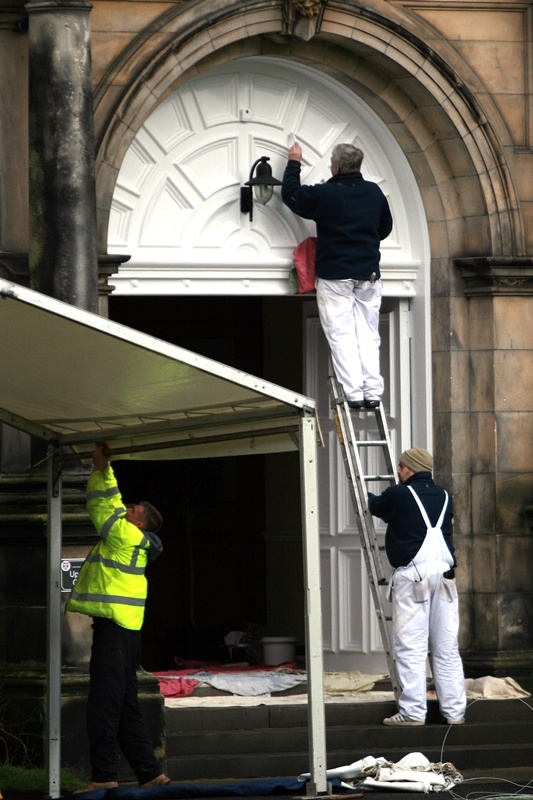Coming up with a fitting way to mark a 600th birthday is not something that routinely crosses the minds of many of us. If it did, the problem of how to squeeze all the requisite candles on to the cake would surely be the least of our troubles.
Rather more pressing would be the need for a spectacular, eye-grabbing celebration perhaps even something majestic.
Thankfully, our future king and queen were only too happy to oblige when St Andrews University’s sexcentenary appeared on the horizon. And so almost six years after they graduated from the institution Prince William and fiancee Kate Middleton will take centre stage on Friday as they launch a party befitting of such an impressive milestone.
The royal visit will be the first undertaken by Prince William in his role as patron of the university’s 600th anniversary appeal, but the celebrations will only just have begun by the time our future king makes his way back to London.
The party will span three years, from 2011 to 2013 and the extended period is no mere indulgence dreamt up by the organisers. Rather it marks the fact that, while a formal charter was granted by Bishop Henry Wardlaw in February 1411, the achievement of full university status came two years later, when it was conferred by Pope Benedict XIII by Papal Bull.
Prince William and Miss Middleton will attend a reception and view the surviving Papal Bull and will then go to the St Salvator’s Quadrangle, where they will meet students and staff and unveil a plaque to mark the official launch of the 600th anniversary.
St Andrews University was really born of necessity as, in the Middle Ages, Scottish students were forced abroad to pursue their studies. By 1410 most had been driven to Paris from Oxford and Cambridge by the Wars of Scottish Independence with England.
So when the Catholic Church was divided by two rival Popes with Pope Boniface IX supported by the French Cardinals while Scotland remained faithful to Pope Benedict XIII Scottish students found themselves in a difficult position. The time had come to establish a seat of learning, of international standing, back home in Scotland.
St Andrews was the obvious choice the seat of the greatest bishopric in Scotland and location of a monastery noted as a centre for learning.
Continued…
In May 1410 a group of masters, mainly graduates of Paris, initiated a school of higher studies. Hence university life began in the town and some of the best international scholars have descended on the tranquil corner of Fife ever since.
Among the notable minds attracted were poet William Dunbar, MA in 1479, and Benjamin Franklin, honourary Doctor of Laws 1759. Among others to study at St Andrews were James Gregory, who designed the Gregorian telescope, Rudyard Kipling, JM Barrie and John Napier, the inventor of logarithms.
The current anniversary campaign will aim to lay the foundation for a seventh century of exploration. Among ambitious proposals are a new graduate school for arts, a Scottish Centre for theoretical physics, an institute for contemporary and comparative literature and perhaps most intriguingly an “Other Worlds” think-tank and observatory.
A full events calendar is set to be unveiled in June, with a golf tournament on the Old Course and a street party among the anticipated highlights.
The sexcentenary is also set to be used as a springboard to launch a £100 million philanthropic fund-raising appeal allowing the university to continue to invest in “people, ideas and excellence.”
A substantial focus will be to generate new funds for scholarships, ensuring a prestigious St Andrews education is accessible to all bright students, regardless of background or circumstance.
Principal Professor Louise Richardson is proud to look back at all that has been achieved by the third oldest university in the English-speaking world.
“Improving our international standing will not happen automatically and it will not be easy. It will require a significant commitment of effort and resources by every member of the St Andrews community.”
A visit by Prince William and his bride-to-be is surely the most promising start imaginable as the institution continues to improve its already enviable reputation.
In May 1410 a group of masters, mainly graduates of Paris, initiated a school of higher studies. Hence university life began in the town and some of the best international scholars have descended on the tranquil corner of Fife ever since.
Among the notable minds attracted were poet William Dunbar, MA in 1479, and Benjamin Franklin, honourary Doctor of Laws 1759. Among others to study at St Andrews were James Gregory, who designed the Gregorian telescope, Rudyard Kipling, JM Barrie and John Napier, the inventor of logarithms.
The current anniversary campaign will aim to lay the foundation for a seventh century of exploration. Among ambitious proposals are a new graduate school for arts, a Scottish Centre for theoretical physics, an institute for contemporary and comparative literature and perhaps most intriguingly an “Other Worlds” think-tank and observatory.
A full events calendar is set to be unveiled in June, with a golf tournament on the Old Course and a street party among the anticipated highlights.
The sexcentenary is also set to be used as a springboard to launch a £100 million philanthropic fund-raising appeal allowing the university to continue to invest in “people, ideas and excellence.”
A substantial focus will be to generate new funds for scholarships, ensuring a prestigious St Andrews education is accessible to all bright students, regardless of background or circumstance.
Principal Professor Louise Richardson is proud to look back at all that has been achieved by the third oldest university in the English-speaking world.
“Improving our international standing will not happen automatically and it will not be easy. It will require a significant commitment of effort and resources by every member of the St Andrews community.”
A visit by Prince William and his bride-to-be is surely the most promising start imaginable as the institution continues to improve its already enviable reputation.
